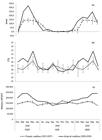Abstract
The present study focuses on the structure and function of phytoplankton community during periods of marked changes in hydrological traits, influenced by an atypical climatic event (La Niña) and its impact on Armando Ribeiro Gonçalves Reservoir of Rio Grande do Norte, situated in the Caatinga biome of northeastern Brazil. The main questions addressed were: What are the effects of environmental factors on the temporal variation of Morphologically Based Functional Group (MBFG) of phytoplankton community? How does the composition of cyanobacterial species shift in relation to high and low trends of phytoplankton diversity? The samples were collected monthly during 2008-2009 and analyzed for pH, temperature, electrical conductivity, dissolved oxygen content and the nutrients, such as, nitrate-nitrogen, ammoniacal nitrogen, total nitrogen and orthophosphate. Phytoplankton samples were collected for both qualitative and quantitative analyses to evaluate species richness index and species diversity index. The data was divided into two distinct hydrodynamic periods of instability and stability. The results demonstrate considerable changes in dissolved oxygen content, water transparency and nitrogen nutrients, which directly influenced the MBFG of phytoplankton community in space and time. The instability of reservoir water was caused by heavy rainfall, which exerts atypical external disturbances. The seasonal variation of MBFG demonstrates a change in cyanobacterial composition and their diversity during instability and stability periods. MBFG VII, composed by colonial cyanobacteria with mucilage, was associated with reduced values of electrical conductance and alterations in pH. The predominance of filamentous species with heterocyst (MBFG III) occurs only during the hydrodynamic stability period and did not show significant association with analyzed parameters. The co-dominance of MBGFs III, V and VII along with high species diversity of phytoplankton community occurred during the second hydrodynamic instability period which was associated with the reduction in water temperature. It is concluded that the decrease in cyanobacterial species dominance and the general increase in the diversity of phytoplankton community are influenced by pluvial anomaly. The higher water level during the period of pluvial anomaly resulted in nutrient pulse and the mixing of water column in the reservoir, which determined the MBPG phytoplankton community distribution.
Keywords:
hydrodynamism; environmental factors; phytoplankton community; morphofunctional groups

 Thumbnail
Thumbnail
 Thumbnail
Thumbnail

